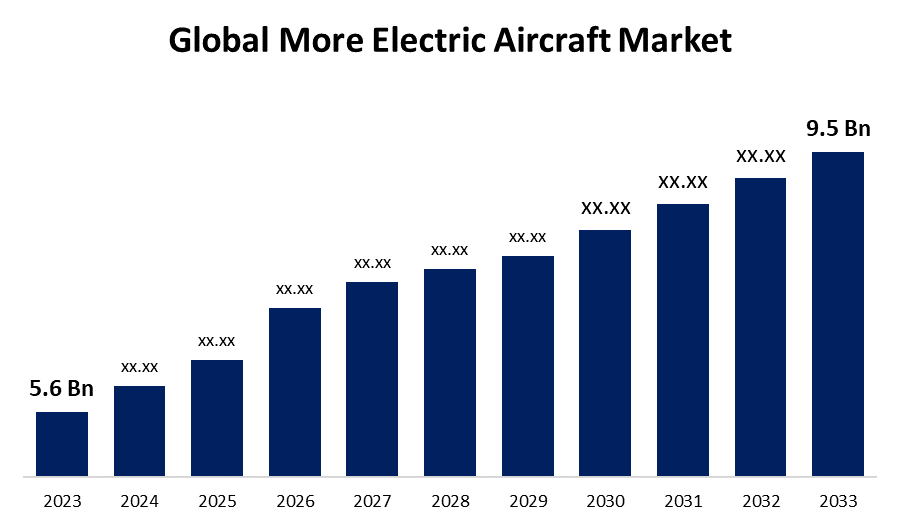Global More Electric Aircraft Market Size, Share, and COVID-19 Impact Analysis, By Platform (Commercial Aircraft (Narrow Body, Wide Body, and Regional Jet) and Military Aircraft (Multirole & Combat and Military Transport Aircraft)), By System (Aircraft Configuration and Management System, Flight Control and Mission Management System, Air Pressurization and Conditioning System, Power Generation and Management System, and Others), and By Region (North America, Europe, Asia-Pacific, Latin America, Middle East, and Africa), Analysis and Forecast 2023 - 2033
Industry: Aerospace & DefenseGlobal More Electric Aircraft Market Insights Forecasts to 2033
- The More Electric Aircraft Market Size was valued at USD 5.6 Billion in 2023.
- The Market Size is growing at a CAGR of 5.43% from 2023 to 2033.
- The Worldwide More Electric Aircraft Market is expected to reach USD 9.5 Billion by 2033.
- Asia Pacific is expected to grow the fastest during the forecast period.

Get more details on this report -
The Global More Electric Aircraft Market Size is expected to reach USD 9.5 Billion by 2033, at a CAGR of 5.43% during the forecast period 2023 to 2033.
The More Electric Aircraft (MEA) market is experiencing significant growth, driven by the aviation industry's push toward sustainability, fuel efficiency, and reduced carbon emissions. MEA technology replaces traditional hydraulic and pneumatic systems with electric alternatives, improving efficiency and reducing maintenance costs. Advances in battery technology, power electronics, and electric propulsion are fueling market expansion, with key players investing in hybrid-electric and fully electric aircraft solutions. The commercial aviation sector, alongside urban air mobility and defense applications, is driving demand for MEA systems. However, challenges such as battery weight, energy density, and charging infrastructure remain. North America and Europe lead the market due to strong RandD investments, while Asia-Pacific is emerging as a key region. Government regulations and incentives further support MEA adoption, shaping the future of sustainable aviation.
More Electric Aircraft Market Value Chain Analysis
The More Electric Aircraft (MEA) market value chain consists of multiple interconnected stages, from raw material suppliers to end users. It begins with component manufacturers providing essential parts like electric actuators, generators, batteries, and power electronics. System integrators then assemble these components into MEA subsystems, ensuring compatibility and efficiency. Aircraft OEMs (original equipment manufacturers) integrate these systems into commercial, military, and urban air mobility aircraft. Service providers handle maintenance, repair, and upgrades to ensure reliability and performance. Regulatory bodies oversee compliance with aviation safety and environmental standards. End users, including airlines, defense agencies, and private operators, drive demand. Collaboration between stakeholders, technological advancements, and regulatory support play a crucial role in optimizing the MEA value chain for enhanced efficiency and sustainability.
More Electric Aircraft Market Opportunity Analysis
The More Electric Aircraft (MEA) market presents significant opportunities driven by the aviation industry's shift toward electrification, sustainability, and fuel efficiency. Increasing regulatory pressure to reduce carbon emissions and advancements in battery technology, power electronics, and electric propulsion are accelerating MEA adoption. The growing demand for hybrid-electric and fully electric aircraft in commercial aviation, urban air mobility, and defense sectors opens new avenues for innovation. Emerging markets in Asia-Pacific and the Middle East present expansion opportunities due to rising air travel and government support for green aviation. Collaborations between aerospace companies, technology firms, and startups are fostering research and development. Despite challenges such as battery limitations and infrastructure gaps, investments in smart grid technology and high-energy-density storage solutions are expected to drive future market growth.
Global More Electric Aircraft Market Report Coverage
| Report Coverage | Details |
|---|---|
| Base Year: | 2023 |
| Market Size in 2023: | USD 5.6 Billion |
| Forecast Period: | 2023 – 2033 |
| Forecast Period CAGR 2023 – 2033 : | 5.43% |
| 023 – 2033 Value Projection: | USD 9.5 Billion |
| Historical Data for: | 2019-2022 |
| No. of Pages: | 245 |
| Tables, Charts & Figures: | 135 |
| Segments covered: | By Platform, By System, and By Region |
| Companies covered:: | AMETEK Inc. BAE Systems plc Bombardier Inc. Elbit Systems Ltd. GE Aviation Honeywell International Inc. Raytheon Technologies Corporation Rolls-Royce Holdings plc Safran Thales Group Others |
| Pitfalls & Challenges: | COVID-19 Empact,Challenges, Future, Growth, & Analysis |
Get more details on this report -
Market Dynamics
More Electric Aircraft Market Dynamics
The transition from conventional aircraft to sustainable aircraft is driving market growth
The transition from conventional aircraft to sustainable aircraft is a key driver of More Electric Aircraft (MEA) market growth. As the aviation industry prioritizes fuel efficiency and reduced carbon emissions, MEA technologies are gaining traction by replacing traditional hydraulic and pneumatic systems with electric alternatives. Regulatory mandates, environmental concerns, and advancements in battery and power electronics are accelerating this shift. Airlines and manufacturers are increasingly investing in hybrid-electric and fully electric aircraft to meet sustainability goals. The rise of urban air mobility and next-generation electric propulsion systems further boosts market expansion. While challenges such as battery energy density and charging infrastructure persist, continued research, government incentives, and industry collaboration are expected to propel the widespread adoption of sustainable aircraft, strengthening the MEA market.
Restraints and Challenges
One major obstacle is battery technology, as current energy storage solutions have limitations in terms of weight, capacity, and charging time, restricting long-haul electric flights. High development and production costs also pose financial barriers for manufacturers and airlines. Additionally, the need for advanced electrical systems increases thermal management complexities and potential reliability concerns. Infrastructure gaps, including the lack of widespread charging and maintenance facilities, further hinder large-scale adoption. Regulatory hurdles and stringent safety certifications add to the time and cost required for market entry. Furthermore, integrating MEA technologies into existing aircraft fleets requires significant modifications. Overcoming these challenges will require continuous innovation, strategic investments, and supportive policies to accelerate MEA adoption.
Regional Forecasts
North America Market Statistics

Get more details on this report -
North America is anticipated to dominate the More Electric Aircraft Market from 2023 to 2033. The presence of major aircraft manufacturers, such as Boeing and key defense contractors, accelerates the adoption of MEA technologies. The region benefits from extensive research and development efforts supported by government agencies like NASA and the FAA, promoting electric and hybrid-electric aviation. Increasing regulatory pressure to reduce carbon emissions and fuel consumption further boosts market growth. Additionally, the rise of urban air mobility and electric vertical takeoff and landing (eVTOL) aircraft in the U.S. and Canada creates new opportunities. Despite challenges like infrastructure limitations and battery constraints, North America remains at the forefront of MEA advancements and commercialization.
Asia Pacific Market Statistics
Asia Pacific is witnessing the fastest market growth between 2023 to 2033. China, Japan, and India are actively developing electric and hybrid-electric aircraft to reduce carbon emissions and fuel dependency. Leading aerospace firms and startups in the region are collaborating on MEA advancements, supported by regulatory policies promoting green aviation. The rise of urban air mobility and electric vertical takeoff and landing (eVTOL) aircraft further accelerates market growth. However, challenges such as limited charging infrastructure, high development costs, and battery technology constraints persist. Despite these hurdles, ongoing research, strategic partnerships, and government incentives position Asia-Pacific as a key player in the global MEA market, driving innovation and adoption.
Segmentation Analysis
Insights by Platform
The commercial aircraft segment accounted for the largest market share over the forecast period 2023 to 2033. Airlines and aircraft manufacturers are increasingly adopting MEA technologies to enhance fuel efficiency, reduce operational costs, and meet environmental regulations aimed at lowering carbon emissions. The transition to electric and hybrid-electric propulsion systems offers substantial benefits, such as lower maintenance costs and reduced noise pollution. Additionally, advancements in battery technology and electric systems are making smaller, regional aircraft more viable for electric solutions. Major commercial players are investing in hybrid-electric aircraft for short-haul routes, while long-term goals focus on fully electric solutions. The growing demand for sustainable air travel, along with regulatory pressure and consumer preference for eco-friendly options, is expected to drive the expansion of the commercial aircraft segment in the MEA market.
Insights by System
The flight control and mission management system segment accounted for the largest market share over the forecast period 2023 to 2033. As MEA technologies replace traditional hydraulic and pneumatic systems with electric alternatives, advanced flight control systems become crucial for ensuring performance, safety, and reliability. These systems are integral for managing complex electric propulsion, energy distribution, and aircraft automation. With the push toward hybrid and fully electric aircraft, the need for optimized mission management systems that improve flight efficiency and reduce energy consumption is on the rise. Integration of AI and data analytics further enhances these systems, enabling better decision-making and route optimization. As MEA adoption grows, the flight control and mission management system segment will continue to expand, playing a vital role in the overall development of sustainable and efficient aircraft.
Recent Market Developments
- In September 2023, A consortium headed by Honeywell International has recently initiated a European Clean Aviation project aimed at developing a new generation of hydrogen fuel cells for the aviation sector. The project brings together 18 partners from 10 European countries, working collaboratively to create an aerospace-qualified, megawatt-class fuel cell propulsion system powered by hydrogen.
Competitive Landscape
Major players in the market
- AMETEK Inc.
- BAE Systems plc
- Bombardier Inc.
- Elbit Systems Ltd.
- GE Aviation
- Honeywell International Inc.
- Raytheon Technologies Corporation
- Rolls-Royce Holdings plc
- Safran
- Thales Group
Market Segmentation
This study forecasts revenue at global, regional, and country levels from 2023 to 2033.
More Electric Aircraft Market, Platform Analysis
- Commercial Aircraft
- Narrow Body
- Wide Body
- Regional Jet
- Military Aircraft
- Multirole and Combat
- Military Transport Aircraft
More Electric Aircraft Market, System Analysis
- Aircraft Configuration and Management System
- Flight Control and Mission Management System
- Air Pressurization and Conditioning System
- Power Generation and Management System
- Others
More Electric Aircraft Market, Regional Analysis
- North America
- US
- Canada
- Mexico
- Europe
- Germany
- Uk
- France
- Italy
- Spain
- Russia
- Rest of Europe
- Asia Pacific
- China
- Japan
- India
- South Korea
- Australia
- Rest of Asia Pacific
- South America
- Brazil
- Argentina
- Rest of South America
- Middle East and Africa
- UAE
- Saudi Arabia
- Qatar
- South Africa
- Rest of the Middle East and Africa
Frequently Asked Questions (FAQ)
-
1. What is the market size of the More Electric Aircraft Market?The global More Electric Aircraft Market is expected to grow from USD 5.6 billion in 2023 to USD 9.5 billion by 2033, at a CAGR of 5.43% during the forecast period 2023-2033.
-
2. Who are the key market players of the More Electric Aircraft Market?Some of the key market players of the market are AMETEK Inc., BAE Systems plc, Bombardier Inc., Elbit Systems Ltd., GE Aviation, Honeywell International Inc., Raytheon Technologies Corporation, Rolls-Royce Holdings plc, Safran, Thales Group.
-
3. Which segment holds the largest market share?The flight control and mission management system segment holds the largest market share and is going to continue its dominance.
-
4. Which region dominates the More Electric Aircraft Market?North America dominates the More Electric Aircraft Market and has the highest market share.
Need help to buy this report?